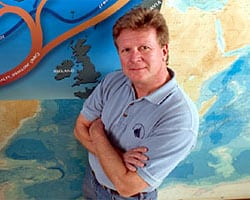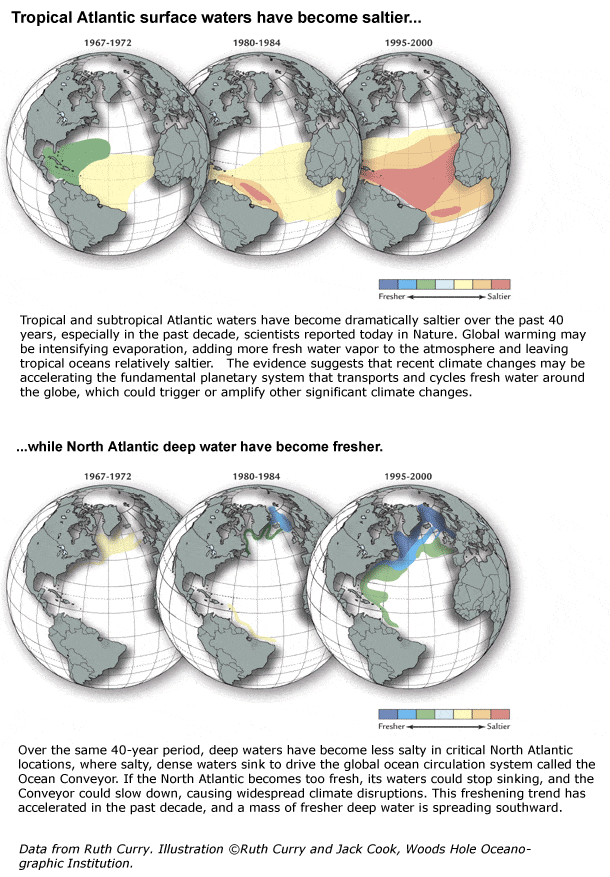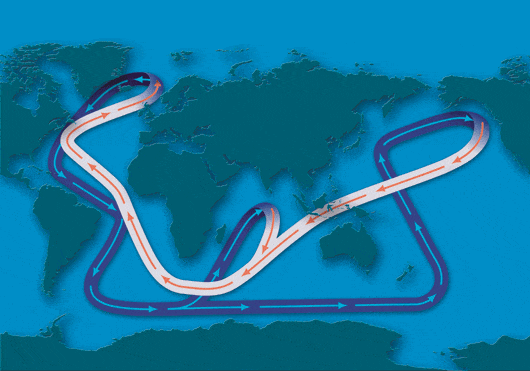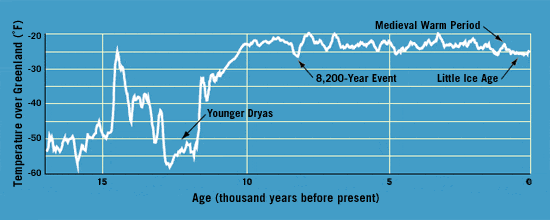Testimony to the Senate Committee on Commerce, Science and Transportation
My name is William Curry. I am director of the Ocean and Climate Change Institute of the Woods Hole Oceanographic Institution (WHOI) and a Senior Scientist in the Geology and Geophysics Department. I have served on the Ocean Studies Board of the National Research Council and on numerous advisory panels for the National Science Foundation and the National Oceanic and Atmospheric Administration.
I study the role of the ocean in climate change on a variety of time scales, trying to understanding how the ocean and atmosphere interact to produce the climate we experience on Earth. My background in geology provides me with a broad perspective on the full range of what Earth's climate system is capable of producing.
In my comments today, I will describe intriguing changes in the ocean that we have detected in only the last two years. I will discuss possible ocean and climate changes we may see in the future if the planet continues to warm. And I will explain what we can do to strengthen our position to predict climate changes, so that we can make the wisest decisions and the best preparations.
In brief, I'd like to make these points:
- The atmosphere and the ocean are inextricably linked in creating Earth's climate. Atmospheric changes tell only half the story.
- The geological record demonstrates that Earth's long-term history is punctuated by climate shifts that happened rapidly-on the scale of decades-and caused very large impacts that lasted for centuries to millennia. These are not blanket changes, but regionally diverse: Different regions will get warmer or colder, wetter or drier.
- These rapid climate shifts are linked to changes in ocean circulation-in particular, to changes in the North Atlantic that make waters there less salty.
- Evidence that has emerged in the last two years shows that over the past four decades, the subpolar North Atlantic has become dramatically less salty, while the tropical oceans around the globe have become saltier.
- We don't know if these changes indicate that we are approaching a threshold that could trigger abrupt ocean circulation and climate changes. Why? Because the models that simulate the workings of our climate system lack essential information. We don't understand ocean dynamics with nearly the same precision that we understand atmospheric dynamics. Which leads to my last point, and a call to action:
- We are scientifically and technologically poised to fill in that critical gap. If we are truly dedicated to understanding and predicting climate change in time to prepare for it, a relatively modest investment in ocean research has large potential payoffs.
Recent Changes in the Ocean
The ocean contains 97% of the water on the planet and plays a large role in the earth's hydrological cycle, which is the movement of water on Earth. In the warm tropical regions, water is evaporated from the oceans, leaving behind and concentrating the salts dissolved in the seawater. The water vapor is transported by the atmosphere toward higher latitudes, where it falls as rain and snow, adding freshwater back into the oceans and diluting salt concentrations at higher latitudes. As a result, the salinity of seawater is higher in the tropics and lower at higher latitudes. This is noticeable if you have ever experienced the saltiness of Caribbean waters compared to those in Ocean City, Maryland, or Cape Cod. Movement (circulation) of salty ocean water from high to low latitudes balances the movements of the water in the atmosphere, off setting some of the salinity diff erences between high and low latitudes.
During the last four decades, oceanographers have observed large changes in the distribution of salinity, which appear to be related to the gradual warming of the atmosphere (see Figure 1). In the tropical regions of the Atlantic, Mediterranean, Indian, and Pacific Oceans, surface waters have increased in salinity, reflecting an increasing rate of evaporation in those locations caused by warmer ocean and air temperatures. At the same time, salinities have been decreasing in the subpolar and polar regions of both hemispheres: The high-latitude ocean is gaining freshwater because of higher precipitation, increased runoff from rivers, and increased melting of glacier ice and sea ice. These salinity changes are unprecedented in the relatively short history of the science of oceanography.
This pattern of salinity change—increasing salinity at low latitudes and decreasing salinity at high latitudes—may be a fingerprint of the warming atmosphere and ocean. The rising concentration of greenhouse gases in the atmosphere is trapping more energy from the sun and affecting the ocean, atmosphere and cryosphere (ice) systems in a variety of ways.
For instance, the atmosphere has been warming for the last century, with about one half of the warming the result of rising greenhouse gas concentrations. During the last four decades, the oceans have warmed over a very large depth range. That indicates that the ocean has mitigated some of the warming expected from greenhouse gas increases because even a small temperature change in the ocean requires an enormous amount of heat energy to be absorbed by the ocean.
The warmer atmosphere and ocean have also accelerated the rate at which ice is melting. As a result, many mountain glaciers are melting, the Greenland ice sheet appears to be melting at an accelerated rate, and there has been a significant reduction in the amount of sea ice cover in the Arctic Ocean. Each of these factors is affecting the way water is distributed on the planet.
The warming of the atmosphere and ocean has a great impact on the patterns and intensity of evaporation and precipitation on the planet. A warmer atmosphere can accelerate the rate of evaporation from the ocean, and it can hold more water vapor (a wetter atmosphere). Thus, a wetter atmosphere delivers much more precipitation to high-latitude regions. These changes in evaporation and precipitation, as well as increased melting of ice, can cause changes in ocean salinity, which affects how the ocean circulates.
Historical Changes in Circulation and Climate
As recently as two hundred years ago a fresher North Atlantic occurred during a period of cold climate conditions known by historians as The Little Ice Age. This was a five-hundred-year-long period of cold conditions affecting Europe and eastern North America. Contrary to what the name suggests, it did not involve ice-covered continents, as in a "real" ice age. But it did cause enough cooling to disrupt human activities. The changes may have been initiated by changes in the intensity of the sun's energy output, but they are linked to a freshening of the subpolar North Atlantic by increases in the delivery of icebergs (freshwater) to the region (see Figure 3).
The cooling associated with the Little Ice Age was small, yet it was large enough to force the Vikings to abandon settlements in Greenland, to advance mountain glaciers in Europe, and to cause severe winters on both sides of the Atlantic. An historic record of the end of the Little Ice Age comes from accounts of George Washington's brutally cold winter at Valley Forge, and his crossing of the ice-bound Delaware River to surprise the Hessians at Trenton. Today, the Delaware rarely freezes.
Much earlier in Earth history, larger climatic events occurred following the rapid freshening of the North Atlantic. The rapid release of freshwater from a large lake near Hudson Bay into the subpolar North Atlantic 8,200 years ago caused a century-long interval of colder and drier conditions over much of the northern hemisphere (see Figure 4).
Earth's long-term climate history is punctuated with rapid changes in climate, which were associated with changes in ocean and atmospheric circulation that were usually linked to abrupt freshening of the North Atlantic. Often the climate impacts were very large, persisted for centuries or millennia, and were characterized by rapid shifts occurring over time spans as short as a few decades.
What does this mean for future climate?
Our understanding of abrupt climate changes like these is still in its infancy, but growing. Much of what I have described about Earth's climate history was discovered by researchers only in the last 20 years. The changes in ocean salinity were detected only in the last two years. Thus, we are just beginning to experience and evaluate the potential effects of changing ocean salinity.
In 2002, the National Research Council published a report called Abrupt Climate Change: Inevitable Surprises, which summarizes the state of knowledge of these types of climate events. The report's authors pointed out that the likelihood of an abrupt climate event in the future was unknown, but was not zero.
Models of future climate disagree over the likelihood of an abrupt climate event. The models that do predict disruptions to the Atlantic circulation say they will occur far in the future. The NRC report also noted that many of the models used to study changes in ocean circulation have inadequate representations of ocean processes. The models may also be less sensitive to salinity perturbations than the actual ocean is. As a result, we are not yet in a position to predict these types of ocean circulation changes.
The climate history of the earth shows that adding freshwater to the North Atlantic disrupts the ocean circulation in ways that cause regional cooling and alter patterns of rainfall and drought. In the future, however, the effects of changing ocean circulation may not be the same-because it makes a difference if a disruption happens sooner rather than later.
Since human activity continues to raise the greenhouse gas concentration of the atmosphere, Earth will continue to experience rising air temperatures. A disruption to Atlantic circulation, if it were to occur in the next several decades, might be felt as colder winters in the Atlantic region. Should it be many decades before a circulation change occurs, the earth's average temperature will rise to the point that the disruption may mitigate the greenhouse warming experienced in the North Atlantic region. Winters would not be colder than today. But the ocean heat that would have been released into the atmosphere in the North Atlantic region remains in the climate system. If the North Atlantic does not receive the heat, some other location will, and that location would warm. The heat is not lost; it is moved to another location.
As greenhouse gases in the atmosphere continue to rise, the average Earth temperature will continue to rise. Yet most humans won't experience the average climate. There will be large regional differences in the climate: Some places will warm much more than others; some places will become wetter; and some places will become drier. The regional differences in climate change will be greatly affected by how the ocean is circulating and how it interacts with the atmosphere.
To better predict these changes, we will require better understanding of ocean circulation processes; more detailed reconstructions of the history of ocean circulation and climate; better simulations of ocean processes in climate models; and a more complete system to observe the state of ocean circulation.
Over the past half-century, satellites and a worldwide network of meteorological stations have been observing and monitoring atmospheric changes over time and space. These have given atmospheric scientists the data they need to make huge inroads into understanding the complexities of atmospheric dynamics.
Oceanographers require similar tools to comprehend ocean dynamics. It's more difficult to understand what you can't see, or monitor, or measure. After all, as terrestrial creatures, we live in the atmosphere, but for most of us, the ocean remains a foreign place. Yet the ocean has significant impact on our lives.
We now have the technological capability to put "eyes" in the oceans that can reveal how the oceans work. A substantial commitment to an ocean-observing system would make a huge difference. It would give us the measurements we need to fill in that big gap in our climate models and make them more representative of the real world.
The ability to accomplish this is within reach. The cost is relatively modest-especially compared to the huge potential economic and societal payoffs-including, for example, improved predictions of energy demands, water resources, crop planting and harvesting decisions, and natural hazards. Perhaps most importantly, they will provide the foundation for making the wisest possible decisions concerning the future habitability of our planet.




